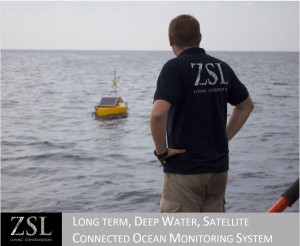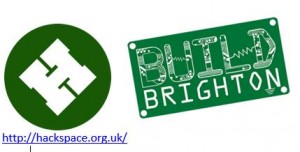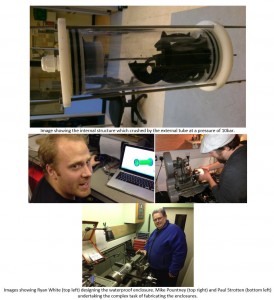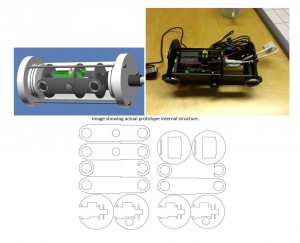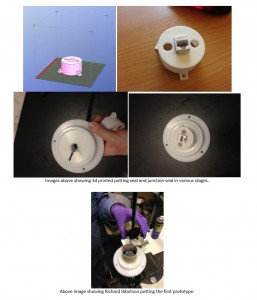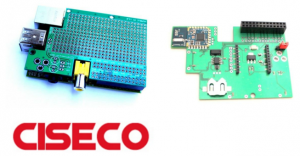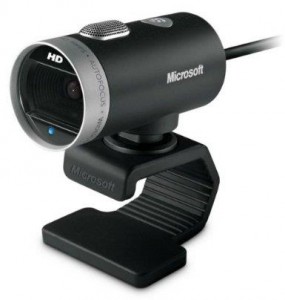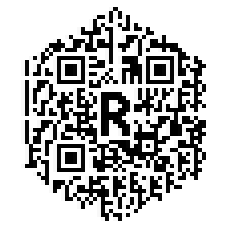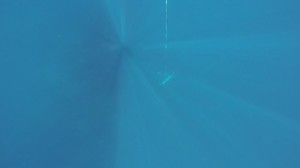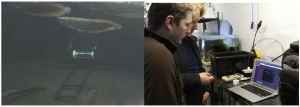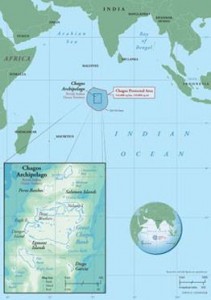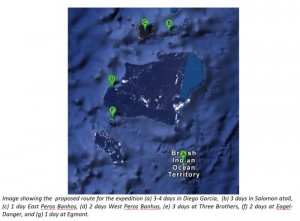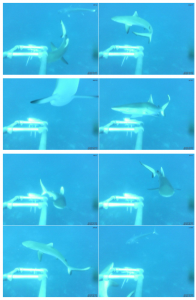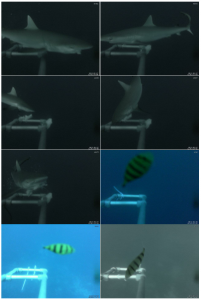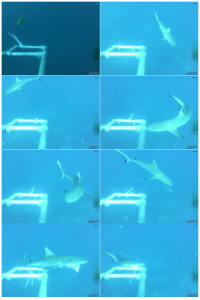|
Welcome back to another jaw-dropping edition of the Good e-Reader Radio show, put the little ones to bed and hide your daughters. Today, I will regale you with tales of SID Display Week and some of the cool tech Peter and myself saw. Mirasol display technology is in-fact not dead, and they have a new smartphone and watch. e-Ink was showcasing a ton of goodies and were displaying the new Sony 13.3 inch e-Reader. Amazon was in the news today, with Kindle Worlds, a new Fan-Fiction writing service that allows authors to actually earn a little bit of money. There was also a new report on Canadians and their eBook buying habits. Finally, IDPF and Book Expo America is right around the corner. Our entire team will be in New York for a week, getting all the news. We will be covering all the major sessions on EPUB3, HTMl5, Self-Publishing, Big Data, the future of the industry and more! Being the main media sponsors has its advantage, as we have interviews with best selling author Sylvia Day, GoodReads CEO Otis Chandler and many more prolific authors. Good e-Reader Radio Show – SID Display Week and IDPF Preview is a post from: E-Reader News |
A Semi-automated Technology Roundup Provided by Linebaugh Public Library IT Staff | techblog.linebaugh.org
Wednesday, May 22, 2013
Good e-Reader Radio Show – SID Display Week and IDPF Preview
Kobo Suspends Google Affiliate Program and Switches to Rakuten LinkShare
|
Affiliate programs are very popular with booksellers, indie bookstores, authors and online websites. Kobo has been running theirs for a number of years and allows people to earn a 5% commission for ebook sales, while devices and accessories generate 10%. Today, Kobo announced that they were severing ties with Google Affiliates and transitioning to the Rakuten Linkshare program. Rakuten has been running their own affiliate program for a long time and taps into not only Kobo but other online retailers, such as Barnes and Noble. Recently Kobo lowered their commissions on their affiliate program across the board. Kobo is decreased it from 8% to 5% and also scraped their tiered system that allowed people who grossed over $1500 in sales to be bumped up to 15%. The Rakuten network allows people a bit more flexibility such as; Direct Links, API Access, and Country Specific data. One of the best features is the Compile a Catalog, which allows affiliates to create a comprehensive and dynamic list of eBooks to appeal to your audience. In order to encourage people to make the switch, Kobo will be giving an extra 2% above the base commission through August 31st, 2013. You can be paid by check or direct deposit, on your transactions and will enjoy the monthly Kobo email that makes you aware of savings and discounts. If you want to be paid by direct deposit, it is only available in Australia, Austria, Belgium, Canada, France, Germany, Ireland, Mexico, Netherlands, New Zealand, Spain, Switzerland, the UK and the US. The main reason Kobo is switching their main affiliate program is because Google themselves are suspending their model in the next few months. Considering Kobo is owned by Rakuten, it makes sense to have their home base where the parent company is. If you are not already a member of Rakuten LinkShare, here are the signup links: Canada Kobo Suspends Google Affiliate Program and Switches to Rakuten LinkShare is a post from: E-Reader News |
News from the Big Six, Apple Antitrust Settlements
| Today, the final piece of the Big Six puzzle fell into place. Months after the initial co-defendants in an antitrust lawsuit settled out of court, the remaining publisher, Penguin, settled with the attorneys general from 33 states for $75 million. This settlement comes less than a year after Penguin settled a similar claim with the Department of Justice. "This proposed settlement is a powerful demonstration of what is possible when federal, state and private class antitrust enforcement lawyers work together," said Steve W. Berman, managing partner of Hagens Berman, in a statement issued by the firm today. "In this case, the level of cooperation was unprecedented, and the results that we were able to deliver to the states and consumers demonstrate that." All of the controversy in these court proceedings surround the claim that five of the Big Six publishers colluded with Apple to prevent Amazon from discounting the price of ebooks in order to further sales of Kindle e-readers. Industry professionals from every corner of the publishing world have weighed in on the issue since it was first raised in 2010, some in favor of the suit brought against allegations of price fixing, but others in support of taking down the corporate empire in Amazon. Despite the lengthy proceedings, today’s statement from the lead counsel actually applauded the publisher for taking the initiative and taking step to move forward in the best interests of ebook consumers. "Penguin’s senior management deserves credit for working with us and the attorneys general to reach a comprehensive agreement in such a hotly contested case," said Jeff D. Friedman, Hagens Berman partner. "They've agreed to a settlement that will go a long way toward making e-book consumers whole and restoring a thriving, again-competitive e-book marketplace." While the terms of the settlement have been agreed upon, it is still ultimately up to the courts to decide if these terms meet the best interests of the consumers. Those proceedings will get underway later this summer, while the lawsuits brought against Apple are slated to begin next month.
News from the Big Six, Apple Antitrust Settlements is a post from: E-Reader News |
Blackberry 10 Coming to the Playbook
|
Blackberry Mexico has confirmed that the new Blackberry 10 operating system will be hitting the Playbook in the next few weeks. This will insure that many of the most popular apps such as Netflix and Instagram will finally be available via our Good e-Reader App Store. Blackberry 10 is the latest operating system that hit the Z10 and Q10 smartphones. It took years of development to ready it for a commercial release and is the last hope of Blackberry to remain relevant in the hardware world. Many top executives at Blackberry have claimed they have no plans to make anymore tablets, as they see them as a dying technology. Instead, the company is betting on licensing out BBM and their BES technology out to Apple and Android developers. Still, the Playbook crowd is tremendously loyal to Blackberry and the fact that BB10 is finally going to hit it, will breath new life into it. This will insure that thousands of apps will be able to run on it. Blackberry 10 Coming to the Playbook is a post from: E-Reader News |
Launch of Kindle Worlds Pays Authors, Originators for Fan Fiction
| Fan fiction is an often hotly-contested issue in publishing. The concept of writers taking existing characters and settings and writing entirely new story lines for them can be deeply divisive. For some authors, having fans write new plots with their established characters is a flattering look at the ways their readers engage with the characters, and symbolizes that the authors’ works were so meaningful to the fans that they weren’t ready to let go of the fun. For other authors, however, fan fiction is akin to theft, and lawsuits have been enacted to halt it. For its part, Amazon Publishing announced today that it is rolling out a new self-publishing platform the lets writers explore their favorite characters through published fan fiction, while still acknowledging the ownership of those characters by the original rights’ holders. Kindle Worlds, a fan fiction platform that will pay both the fan fiction author and the original authors royalties from the sales, already has inked deals with several major book and television series. Under this royalty structure, the authors will continue to earn 35% of net sales. "Our books have generated a massive amount of fan fiction, and we see this as an evolution in publishing and a valuable way of broadening our brands and engaging fans," said Leslie Morgenstein, President Alloy Entertainment. "When working with Amazon Publishing on this scale, we know we're in good hands and everyone will benefit." "Seeing Pretty Little Liars fans adapt and create their own stories is both exciting and flattering and I think what Amazon Publishing is offering through Kindle Worlds is a great way to reward their ingenuity," said Sara Shepard, author of Pretty Little Liars. Several authors have already signed on to have their works included in this platform, or to create new content within Kindle Worlds. Amazon Publishing will be working with the original rights’ holders to set guidelines for what is deemed acceptable to ensure the integrity of their original works.
Launch of Kindle Worlds Pays Authors, Originators for Fan Fiction is a post from: E-Reader News |
Big Library Read: “The Four Corners of the Sky” Discussion Questions
| Are you participating in the Big Library Read? With so many patrons of your library simultaneously reading the featured eBook "The Four Corners of the Sky" by Michael Malone, now is a great time to spark conversation. Whether you host book club meetings or use social networking for these discussions, get the conversation started with this Reading Group Discussion Guide, provided by our Big Library Read partner, Sourcebooks. Encourage users to think of their own questions to prepare for the Facebook chat with the author tomorrow (May 23rd) at 8 p.m. ET.
To save you some time, we’ve posted the discussion guide questions below:
1. Do you think Annie and her father are at all alike?
2. Raffy said, "That's Jack's gift. To make you feel it. He was an artist…He did it for art." Do you agree or disagree? Could Jack be considered an artist? Do you think that was why he did what he did?
3. Who does Jack love? How does he show it? How do other characters in the book demonstrate love in different ways? How do the important people in your life demonstrate love? How do you show that you care about someone?
4. When Annie is 17, her father comes to visit and wants her to come and meet him the night before she leaves for Paris, but she refuses. Why doesn't she go? Would you have gone in that situation?
5. How does forgiveness play a role in Annie's relationship with her father? How does forgiveness play a role in all relationships? Which of your relationships requires the most forgiveness?
6. Jack is famous for telling stories. Is there a difference between the stories Jack tells to Annie and the ones he tells to the people he's conning? Are stories necessarily lies?
7. Jack promises to leave Annie a million dollars. Of all the promises he made and broke, he keeps this one. Why does he keep this particular promise? Is this the one promise Annie would have chosen for him to keep? Which promise that Jack broke do you think Annie would have traded for this one?
8. Like the puzzle at Pilgrim's rest, there are many different pieces of Annie's life that have to come together before she feels fulfilled. In the end, it was Dan who put the final pieces together, who helped her make her life complete. What do you believe it takes to make a life complete and fulfilling?
9. Annie said of her father: "He's a crook. That's a fact." to which Raffy replied: "Facts have nothing to do with this." Is Jack really just a criminal, or is there more to him than Annie wants to admit? What kind of person do you think Jack really is?
10. Look at the family history, as told by Kim in chapter 6. From "The Boss" to Annie, what traits do all the Peringrine's have in common? Are there any exceptions? What traits are shared by your family? Are there any exceptions in your family?
11. Sam tells Clark that she wants Annie to be happy. "Fall in love and be happy," she says. Does falling in love necessarily make people happy? Did it make Annie happy?
12. Annie spends much of the novel wondering about her father and her 'real' mother, even though she has Sam and Clark. Who is Annie's family? How do you define family? Who makes up the family that you have chosen for yourself?
13. What's your opinion of Brad? Does the manner of his death affect your view of him?
14. Sitting at La Loca, Annie goes through her father's old business cards and admits that she loved him just as much as everybody else who had fallen for his schemes, and that "love was the biggest con there was." Did Jack con Annie and the rest of his family? Do you agree that love is a con? When have you felt conned by love?
15. Look at Clark and D.K.'s reaction to Annie joining the Navy. Both of them are veterans of the Vietnam War, with vastly different experiences and feelings toward the military. How has that affected their views of world? If you know anyone who was or is in the military, how has that service affected their world view?
16. When Jack covered up his father's murder with the fake suicide note, was he really protecting Sam? Or was it about protecting his mother or himself? What would you have done in the same situation? In what situations would you consider it acceptable to evade or lie to the authorities?
17. Our history can shape who we are as people. Jack and Sam came through a very sad and abusive childhood to grow into very different people. How has your childhood shaped your present? Do you have siblings that grew up with you, but turned out to be very different from yourself? Why do you think that is?
18. Annie had been searching for her mother all her life, while Ruth never knew she had a daughter. What do you think Ruth and Annie were feeling as they sat across from each other at that table in Cuba? How do you imagine you would have felt in Annie's shoes? In Ruth's?
19. Annie, Sam, Clark, and Jack all face death or abandonment at some point in their lives. Sam takes comfort in movies, Annie in speed. How has death affected each character's approach to his or her own life? Have you experienced a traumatic loss that drastically affected your approach to your life? In what ways did your behavior change after that loss?
20. Look at the different ways Sam and Annie respond to the news that Jack might be dying. Compare them to the family of Coach Ronny Buschstabe, whose funereal Annie accidentally attended. Which family do you relate more closely with? Is there a "normal" way to grieve?
21. Annie started this story at 90 mph in her Porsche and ended it walking down the aisle and then standing at a grave. What happened to make Annie slow down in life? What events have occurred in your life to encourage you to take things a little slower? Did you always recognize those events or people at the time?
Melissa Marin is a Marketing Specialist at OverDrive. |
URL: http://feedproxy.google.com/~r/OverdrivesDigitalLibraryBlog/~3/Z9cDo4pnpnA/
Qantas Commissions Series of Flight-Length Books
| While US lawmakers continue to debate the merits or lack of justification for in-flight bans on electronic devices, Australian airlines Qantas is taking a different approach by commissioning a series of paperback books that are the perfect length for an extended flight. The series, called “A Story for Every Journey,” will be published by Hachette and feature some of the more popular genres based on typical airport sales like thrillers and non-fiction. “It occurred to us that, in this world of Kindles and iPads, the last bastion of the humble, paperback novel is actually at 40,000 feet,” said Droga5 Sydney Creative Chairman David Nobay in an interview with Advertising Age. “Just take a look at the bulging shelves at any airport bookstore. But, for all its relative clumsiness, there’s an unmistakably reassuring charm about thumbing through a good book as you recline amongst the clouds.” These flight-length titles will be created with the purpose of allowing passengers to finish their books just as the flights land, even allowing for time for passengers to sleep or stop reading for meals on longer flights. The estimates on book length are actually calculated based on average reading speed. “According to our literary friends at Hachette, the average reader consumes between 200 and 300 words per minute, which equates to about a page per minute,” said Mr. Nobay. That idea was applied more specifically to the shorter novels and flights, but “for the longer flights, we accommodated some napping time and meals,” Mr. Nobay said. “After a few hours with a fine Qantas in-flight meal with Australian Shiraz, most people need a break from reading.” If this concept in reading takes off (pun intended) and if lawmakers insist on holding to strict regulations on the use of mobile devices during air travel, there is potential for a surge in not only print-reading, but also a shift towards more books being written with an intentional audience already in mind.
Qantas Commissions Series of Flight-Length Books is a post from: E-Reader News |
A Closer Look at Sony’s New 13.3″ E Ink PDF Reader Prototype (Videos)
| Earlier this month Sony revealed that they are planning on releasing a trial run of a new PDF reading device later this year in Japan that uses a 13.3″ Mobius E Ink screen. Sony’s device is the first to use a Mobius display, and that’s because Mobius was co-developed by Sony and E Ink in [...] |
URL: http://feeds.the-ebook-reader.com/~r/feedburner/cmWU/~3/18alsGDCC9I/
Juvenile and Young Adult Summer Reading- Part 1
| I became acquainted with the nomadic Cullen family and the small unassuming town of Forks, Washington, a few summers ago. I'll admit I was not originally a fan of 'Twilight'. Several close friends had tried convincing me of the merits of the four title series by Stephanie Meyer. However, I didn't believe that any adult could enjoy a world of teen vampires who fall in love against the backdrop of the gloomy Pacific Northwest. Eventually, I agreed to try the first book and to my surprise I became immersed in the story. I stayed awake at night devouring the tale of Bella, Edward, and Jacob. The series became an international phenomenon, and like 'Harry Potter', the story was so inviting that many who read it (including me) wished they could be a part of this magical story. And that is the beautiful thing about reading! While turning those pages, you ARE a part of the story.
The Hot Reads:
Each summer, I create a "hot reads" list; titles that are causing a stir within the book world and first title on the list is the National Bestseller 'The Mysterious Benedict Society' by Trenton Lee Stewart is a magical series with elements of Charlie and his Chocolate Factory as well as the escapades of our old friend, Harry. When a peculiar ad appears in the newspaper, dozens of children enroll to take a series of mysterious, mind-bending tests. But in the end, only four very special and gifted children will succeed and be invited to attend the prestigious Learning Institute for the Very Enlightened.
I have a feeling that 'Wonder' by R.J. Palacio is going to be the book everyone is talking about this summer. The story chronicles the fifth grade year of Auggie Pullman who was born with a facial deformity. It starts "I won't describe what I look like. Whatever you're thinking, it's probably worse." I think I might select this one as the summer's first "hot read". It will be a good one to begin with, a new season and a new perspective. What will you read this summer?
These titles and many more great summer reads are available for purchase in Content Reserve in the Summer 2012 YA/Juvenile Read-A-likes list.
Renee Lienhard is an Analyst for the Collection Development team at Overdrive |
URL: http://feedproxy.google.com/~r/OverdrivesDigitalLibraryBlog/~3/Bzyw5di6MgY/
Long term, deep water, satellite connected ocean monitoring system
| Conservation, hackspaces and Raspberry Pis. And sharks. How could this not be the blog of the day? Gary Fletcher of ZSL sent us this report. |
The e-Reader and e-Paper Outlook for 2013-2014
|
Sid Display Week is happening right now in Vancouver, BC. This conference mainly showcases the latest screen technology for smartphones, televisions, advertising, and, of course, e-readers. We talked to some of the leading companies today and got their outlook on how the current e-reader landscape is shaping up and where the industry might go later this year and into 2014. The e-reader industry is not as alluring as it once was. Over 24 million e-readers will be shipped this year, according to E Ink and Freescale Semi-Conductors. The competition and radical price-drops in this sector are benefiting customers with low-prices of some really quality stuff, but it’s dissuading many companies from entering in or getting out. Neonode, Mirasol, Plastic Logic, Pixel Qi, Bridgestone, and many other companies have entered the competitive landscape of e-readers over the course of the last few years. Almost all of them have abandoned making devices and either got out completely or turned to licensing their technology to other companies. Bridgestone and Plastic Logic got out of making devices and abandoned the sector altogether. Pixel Qi turned to licensing its plastic display screens to government, military, and private businesses. Even the head boss Mary Lou Jepsen jumped ship and is now working for Google as the Head of the Display Division. Qualcomm decided against participating in the e-reader space and instead is working on smartphones and wearable technology. Neonode has something cooking in its RND labs and announced a new IR display screen, but details are minimal. E Ink, the e-paper found in almost all of the current generation e-readers on the market, is optimistic. Most companies that make readers based on their technology will continue to do so for the next few years. Amazon, Barnes and Noble, Kobo, Sony, Pocketbook, Ectaco, and Bookeen remained committed to the spirit of digital reading devices. So how will e-readers change in the next few years? Freescale thinks that many companies will begin to shift towards its i.MX6 Solo processors. The chip has 256 KB of L2 Cache and compatible with 32 bit DDR3 memory chips. It will provide e-readers with faster page turns and a better experience than the current crop of i.MX5 processors that are getting a little bit long in the tooth. We will also continue to see larger screens come down the pipe, as evident in the new Sony 13.3 inch e-reader. It is geared towards academics and PDF enthusiasts. E Ink verified with us that the new flexible display panel can be tailored towards any size, it depends on the cut. So we may see a resurgence in 9.7 inch e-readers that have the weight reduced significantly. Onyx Boox, Qualcomm, Yota, and E Ink think that secondary e-paper screens are the way the industry is moving right now. Google Glasses is the poster child for wearable technology and the internet is rife with Apple iWatch rumors. The truth is, e-paper watches have been around since the Pebble captured the Kickstater imagination by offering a pseudo e-paper experience and pairing it with your smartphone. Onyx, Yota, and Mirasol all think that secondary displays on the back of your phone is the way to go. E Ink formed a relationship with Japan based Seiko a few years ago. They have been pumping out e-paper watches for awhile, and the technology is fairly refined. It will be interesting to see if the broad non-urban type of customer would adopt a secondary display on their phone. Potential uses include Maps, Google Now, Text Messages, and other features. There is an air of uncertainty at SID on the customers, but vendors are expressing a ton of interest. There is one major trend this year at SID in relation to e-paper: advertising. We talked to many small companies involved in digital signage, and they are all marketing e-paper price tags, screens merged together for retail signs, freezer tags, and grocery store fare. E Ink announced two major new technologies at SID, and focused on this emerging sector. I think the company is realizing it can’t have all of its eggs in one basket and is branching away from its bread and butter market. Many small companies have told us that grocery stores and retail are responding in a big way. The tech is still too expensive to replace paper in the short term and only the majors can afford it. Still, there is something alluring at being able to update billboards and price tags on the fly. There is strong WIFI integration with this technology, so you can change the price without having to replace them manually. If it was raining outside, you could set a dynamic program to reduce the prices on umbrellas. Lord knows we need them in Vancouver. To sum it all up, e-readers will remain relevant for the next two years. They will become faster and more responsive. There will also be more choice in the different sizes of screens available, as many vendors are starting to deviate from the six inch standard. You will start to see more e-paper in the retail and produce environment, and secondary display screens will start to emerge.
The e-Reader and e-Paper Outlook for 2013-2014 is a post from: E-Reader News |
Pocketbook Touch Lux e-Reader – First Look
|
During the SID Display Week in Vancouver BC, we got our hands on one of the new e-readers that Pocketbook announced a few weeks ago. The Pocketbook Touch Lux is the new kid on the block, and we go hands-on to check out what this device brings to the table. The Pocketbook Touch Lux features the same HD E Ink Pearl display found on the Kindle Paperwhite and Kobo Glo. The exact resolution is 1024×758 and has a front-lit display, which is optimal for reading in the dark. It also has 256 MB of RAM, 4 GB of internal memory, and a SD card support for up to 32 GB of memory. Battery life should be good up to 7,000 page turns. It also has an audio jack so you can listen to audiobooks and music. Sometimes Pocketbook e-Readers feel particularly slow. I have a feeling that most of the internal components are selected from Ricks Restorations bone yard. If you have ever seen the show, it features a slew of crazy characters in Las Vegas that buy and repair vintage items and make them as good as new. Regular viewers of the show are familiar with his bone yard, where rusted items go to die and are cannibalized for parts for existing projects. It feels like Pocketbook paid a visit to said bone yard and randomly selected old computers and beat up monitors and threw them into the Lux. Still, there are some cool features found on this e-reader. Pocketbook borrowed a page out of Kobo’s playbook by adopting its own statistical ebook menu. It shows you how many books or pages you have turned. You can also share some of your reading habits with your friends via Facebook. Pocketbook Touch Lux e-Reader – First Look is a post from: E-Reader News |








